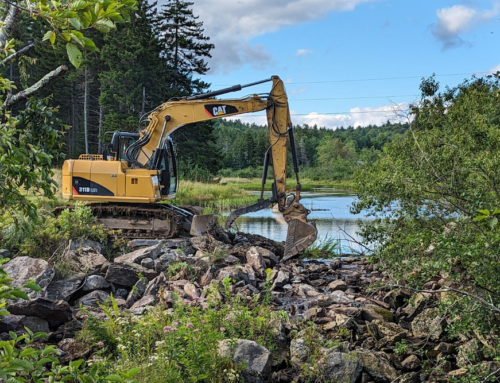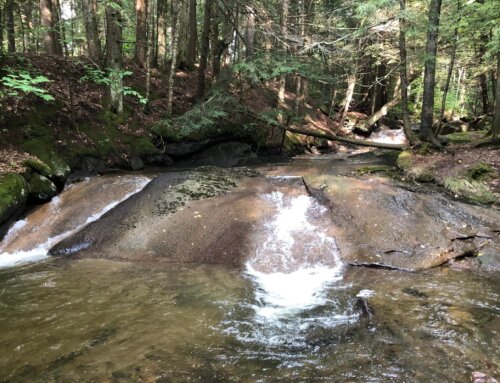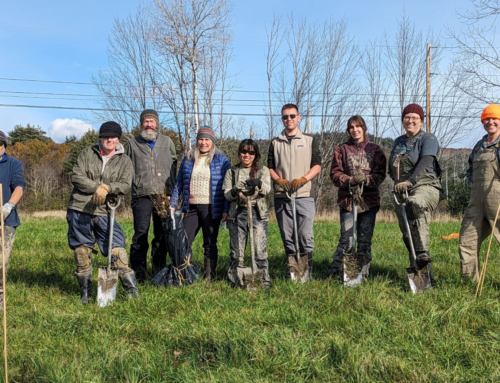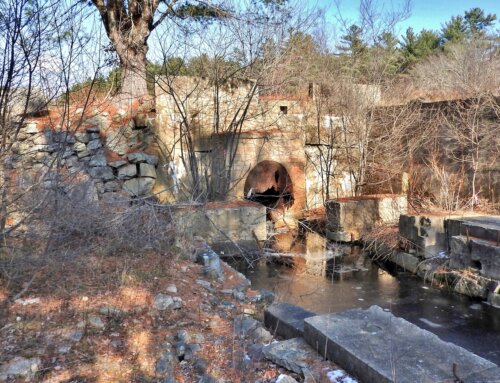Hebron Will See Healthy Free-Running Brook Once Again
HEBRON, Conn. — Throughout most of the Salmon River watershed, water runs cool, clear and unobstructed. But cold-water fish trying to travel up or down Raymond Brook in Hebron, are met with warmer water and eventually can’t pass a small, man-made dam built years ago for a summer camp that no longer exists. This week, all that will change.
Starting on July 19, a group of local and national environmental organizations, including the Connecticut River Watershed Council, American Rivers, The Nature Conservancy, NOAA Restoration Center and the Connecticut Department of Environmental Protection, Inland Fisheries Division, have begun removing this four-foot dam, returning the river to its natural state, and re-connecting 41 miles of high quality habitat. The result will in time allow the brook to return to its natural state, allowing fish to pass in both directions and providing other species, such as freshwater mussels, with higher quality habitat.
“Rivers and streams throughout New England are fragmented by dams. Raymond Brook dam is just one of thousands of small dams that no longer serve a purpose,” said Laura Wildman, director of river science with American Rivers, who played a key role in the project providing all of the field investigation and engineering services. “By removing these remnant structures from our rivers, our communities can once again experience abundant fisheries and healthy rivers. This project is a great example of how landowners, conservation groups and agencies can work together to restore our region’s natural heritage.”
“This small dam blocked a huge amount, over 16 miles, of upstream riverine habitat within the Salmon River Watershed,” said Brian Murphy, senior fisheries habitat biologist with the CT DEP Inland Fisheries Division, the lead agency responsible for making this project happen, “With its removal, juvenile Atlantic salmon, American eel and native resident riverine species such as brook trout will now be able to access a more complete suite of instream habitats necessary for survival.”
The dam owner, tired of the liability associated with a deteriorating dam and looking to turn a muck-filled pond back into a gently flowing stream, was more than supportive of the restoration project and the opportunity to partner with local and national groups to ensure its success.
“The diversity of species found in the brook upstream and downstream of the dam made removing it an easy decision for us to make,” said Shelley Green, program director for The Nature Conservancy, which played an integral role in funding and conducting a mussel survey at the site. “We were also very lucky to have the owner of the dam willing to have it removed.”
Groups like the Connecticut River Watershed Council have been serving as stewards of these streams for decades and have, in recent years, begun working with American Rivers and other partners to restore access to spawning areas for migratory fish. This project is part of that watershed-wide effort to preserve and restore habitats for migratory fish in the Salmon River and its tributaries, a problem facing rivers in Connecticut and beyond.
“Connecticut River Watershed Council is proud to continue its ten years of success in restoring habitat connections for migratory fish. Removing a dam restores a river’s integrity; I’m looking forward to seeing fish swim through there for the first time in fifty years,” says Megan Hearne, River Steward with the Connecticut River Watershed Council, which is the project manager for removal of this dam.
The removal of the Raymond Brook Dam is one of roughly 40 dams slated for removal this year and is a model for what can happen when the right partners come together to reawaken a stream and a community. As dams that were erected decades ago continue to age and outlive their original purpose, removal of some of these structures offer communities the opportunity to eliminate a potential safety hazard while restoring the river and turning it back into a stream fishers and boaters can enjoy.
Funding and technical assistance for the removal was provided through the partnership between NOAA Community-based Restoration Program and American Rivers. This project is one of several in the Northeast that is benefiting from the partnerships that NOAA forges.
“NOAA is pleased to contribute to this partnership to remove the Raymond Brook Dam,” said John Catena, NOAA Restoration Center’s Northeast Regional Supervisor. “The Raymond Brook Dam is one of 64 dam removal projects NOAA is working on or has completed in the Northeast, and we look forward to continuing to work with local communities to restore diadromous fish passage.”







